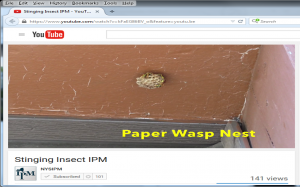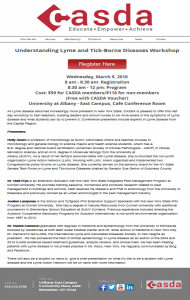A chemical smell wafting through an upstate middle-school classroom last fall ended up sending six students to the hospital. What happened?
A member of the custodial staff sprayed wasp killer by a fresh-air intake. Some of that spray ended up in a second floor classroom. Fourteen students and two staff members felt ill, according to a newspaper account; in fact, the school was evacuated for more than a half hour.

Need help identifying a pest and what to do about it? What’s Bugging You? has the information you need.
The school was fined $5,500 for violating three pesticide regulations. But incidents like this are preventable by practicing integrated pest management.

The NYS IPM Program offers resources such as this video about stinging insects and IPM strategies that reduce the risk of stings.
Many state regulations pertain to pesticide use in and around schools. You can find a synopsis here. But first and foremost — anyone who applies pesticides on school property must meet pesticide application certification requirements. (The same applies to child care centers, office buildings, or any other commercial or public property.) If the certified applicator is a school employee, then the school itself must be registered and appropriately insured.
Neither the school’s pesticide-application notification requirements nor the Child Safe Playing Fields Act were violated, since each provides exemptions for the use of small containers of aerosol products in an imminent threat from stinging and biting insects. Regardless, a certified pesticide applicator must apply them, and, if applied by a school staffer, the school must be registered.
School staffers can obtain and maintain commercial pesticide licenses after getting the right education credits and passing their exams. You can find information about pesticide certification on the Pesticide Safety Education Program website, including information about upcoming classes.

Organizations such as BOCES and CASDA often ask NYS IPMers to present at their conferences, such as this upcoming workshop on ticks and tick-borne diseases.
Consider: without the basic knowledge inherent in getting a license, how can you be sure that staff are aware of the laws that keep incidents such as this from occurring? Who will be qualified to choose a pest management contractor when the need to protect students from the threat of pests — whether increased risk of asthma from mice or cockroaches, rashes from poison ivy, or anaphylactic shock from a wasp sting — relies on an expert’s help? And how will school personnel know what steps they can take to not only deal with existing (and potentially costly) pest issues, but also prevent new ones from taking place?
Answer: Be sure your maintenance staff gets the education needed to stay up to date with the latest pest management information.
The New York State Integrated Pest Management Program has resources to help schools with their pest issues. Visit the NYS IPM Program’s school webpage. Learn about specific pests, including stinging insects. Sign up for our blog, The ABCs of School and Childcare Pest Management. Send staff to classes offered by our experts.
We are here to help address your pest management needs.





